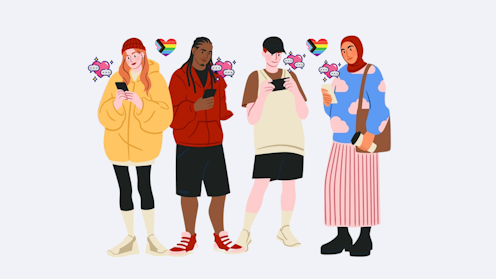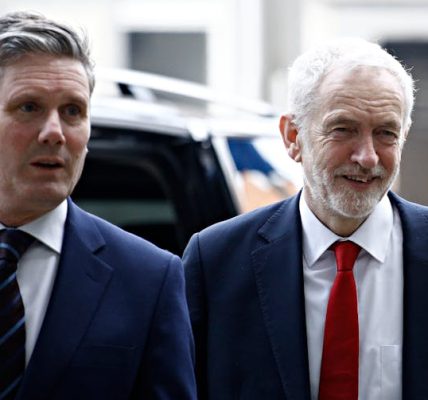Dating app categories could be shaping you more than you know
Any account of love and dating in the 2020s is incomplete without addressing an uncomfortable topic: are our encounters with technology shaping who we are and how we desire?
Dating apps such as Tinder, Bumble and Feeld allow users to choose from dozens of genders, sexualities, desires and relationship types. Commonplace descriptors such as “straight”, “gay” and “bisexual” are now joined by labels including “polysexual” (an attraction to multiple, but not all, genders), “skoliosexual” (an attraction predominantly to people who don’t conform to traditional gender norms) and “heteroflexible” (an attraction that is mostly heterosexual with some exceptions).
But do these categories provide a more accurate representation of the world beyond the app? Or do they partly construct the world they claim to describe?
As a regular user of gay dating apps throughout the late 2000s and early 2010s, I discovered a menu of categories to describe myself. There was everything from “twinks” (slim build, youthful appearance and little or no body hair) and “otters” (the same but with a bit more body hair and a more masculine appearance) to “bears” (large build and lots of body hair) and “muscle daddies” (older with a muscular physique).
I quickly understood how to maximise my success on the app by hacking the algorithm: the curated buzzwords in my bio, profile pics that struck the right balance between “sexy” and “intelligent”, how often to use the app and when. If the app gave prominence to a certain “category” of gay man in its listings, I was more than willing to present myself as that category.
But, in the process, the line between the category and the thing being categorised (me and my desires) became increasingly impossible to untangle.
This experience inspired research in my new book Rainbow Trap, which investigates the technical aspects of app design and how the provision of more “inclusive categories” for LGBTQ+ communities often does nothing to reconfigure the narrow accounts of desire encoded in the tech.
Dating today can feel like a mix of endless swipes, red flags and shifting expectations. From decoding mixed signals to balancing independence with intimacy, relationships in your 20s and 30s come with unique challenges. Love IRL is the latest series from Quarter Life that explores it all.
These research-backed articles break down the complexities of modern love to help you build meaningful connections, no matter your relationship status.
Writing in the early 2000s, science and technology scholars Geoffrey C. Bowker and Susan Leigh Star coined the term “convergence” to describe what happens when “people get put into categories and learn from those categories how to behave”. Philosopher of science Ian Hacking similarly used the term looping effect“ to describe the multi-directional relationship between a category and the “thing” being categorised.
These encounters, however, highlight a fundamental tension between queer communities and classifications: the classifications used to describe us also come to define us. This can determine what doors are opened and closed and who we are allowed to be.
Thinking back to my early forays into dating apps, I would often assign myself to the category of “twink”. Although used by app designers to assist with the algorithmic sorting of users, the identity felt contoured to my life.
The connections suggested by the app, based on my self-categorisation as a “twink”, felt as if they reflected who I was and what I had always wanted. And, for a period, I believed it.
However, in hindsight, I don’t know if I was ever really attracted to men with 26-inch waists and hair frazzled by too much bleach. I had limited myself to what the app told me I should like. But desire isn’t so easily put into a box.
Getting critical about categories
Underpinning the mechanics of all dating apps are categories, and we can learn a lot about love and dating by thinking critically about the categories used.
Between 2021 and 2023, Tinder reported a 30% increase in the use of gender identities other than “male” or “female” on the app, creating more than 145 million new matches. Identification with the label “non-binary” also more than doubled in just one year.
In 2023, the dating app Feeld (which describes itself as designed “for the curious”) reported that more than half its users who identified as “heterosexual” connected with someone on the app who did not identify as “heterosexual”. Feeld also has claimed that over 180,000 people “changed their sexuality” during their first year of using the app and that “the longer Feeld members are on the app, the less heterosexual they get”.
I am not suggesting that our navigation of love and dating through the prism of technology (and its growing menu of categories) is making us more queer – as these technologies could just as equally be making us more straight. But whatever is happening, it is clear that assigning yourself to a particular category opens and closes opportunities for love and desire.
It is app designers who then hold the power to decide what connections are made – for example, whether “twinks” connect with “bears”, whether your category features first or last on the home page. Because the classifications used to describe us are also now defining us, app designers partly shape how you think about yourself and your desires. This power does not stop when you turn off the app, it extends into offline worlds too.
So, for app users, be open to how your encounters with categories shape who and how you desire. Who will the app include and exclude based on your self-categorisation? And is that the experience you necessarily what?
Kevin Guyan does not work for, consult, own shares in or receive funding from any company or organisation that would benefit from this article, and has disclosed no relevant affiliations beyond their academic appointment.



